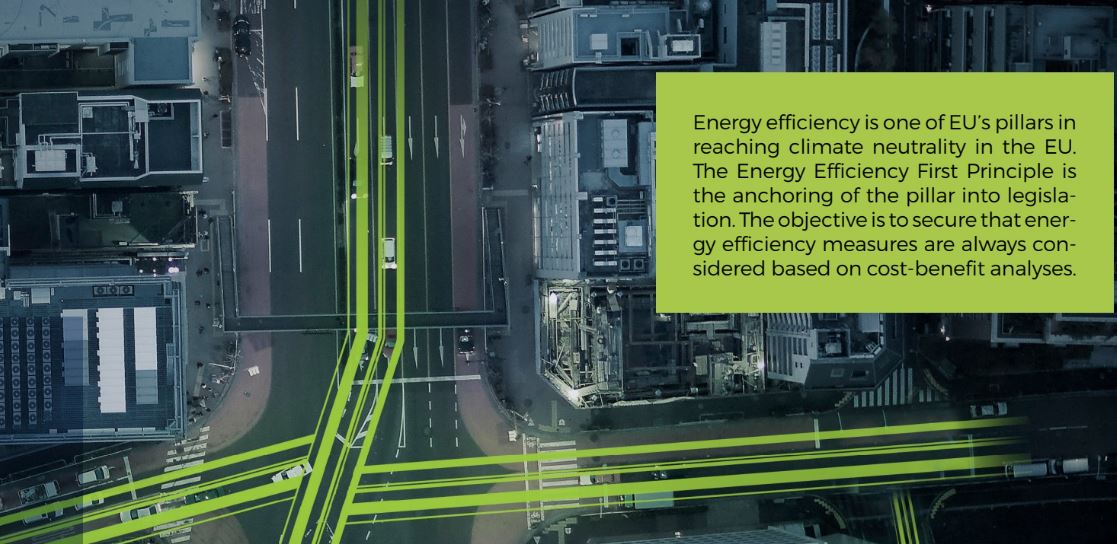Dependence on foreign energy supply to the European Union is not sustainable, not for social Europe nor the climate. The heating sector is one of the most important sectors to make sustainable, as it is heavily dependent on natural gas and has a significant impact on the average citizens’ economy. Therefore, the Energy Efficiency First principle is very important for the future of Europe.
By Carsten Østergård Pedersen, Business Development Director
Asbjørn Bjerregaard Ebbesen, Advisor, Public Affairs
Rune Kaagaard Sørensen, Student Assistant
Published in Hot Cool, edition no. 2/2022 | ISSN 0904 9681 |
The best weapon against a growing problem
Consolidation of the Energy Efficiency First principle in EU’s Fit-For-55 negotiations is becoming significantly more important as the climate, social Europe, and our energy security calls for a change in how we get our energy and how we use it. IEA argues that 40% of our carbon reductions towards 2050 should come from energy-efficient solutions; however, we need to double the pace of energy-efficient solutions to stay within the Paris Agreement goals[1].
Energy efficiency also plays a crucial role in our energy security. Prior to the Ukraine conflict, we saw unprecedented prices on natural gas, which is the most used energy source in the European Union after oil[2]. However, experts only expect higher prices due to the current geopolitical conflict. The situation is expected to have made more than 80 million Europeans living in energy poverty, which will only get worse. However, 1% in energy savings is expected to reduce natural gas imports by 2,6%, and energy efficiency has proven to be the most impactful measure on lowering natural gas imports.
The heating sector is the most important sector to focus on. It represents 50% of Europe’s total end-use consumption, and fossil fuels still deliver 75% of all heating within the European Union[3]. Moreover, putting energy efficiency first in the heating sector can therefore lower carbon emissions, lower import of natural gas, and lower citizens’ energy bills.
Energy efficiency is one of EU’s pillars in reaching climate neutrality in the EU. The Energy Efficiency First Principle is the anchoring of the pillar into legislation. The objective is to secure that energy efficiency measures are always considered based on cost-benefit analyses.
How to create energy-efficient heating
To create a more energy-efficient heating sector, the EU should focus on deploying fourth-generation district heating individual heat pumps and lowering the total heat demand. Luckily, all the technologies are ready for deployment today.
First, local authorities should make strategic heat plans that can secure a fast and cost-effective transition of local heating towards energy-efficient solutions that run on renewable energy and surplus heat. There is a massive untapped energy potential in local communities such as geothermal energy and surplus heat from industries, data centers, and soon Power-to-X. Surplus heat alone is expected to deliver 25% of the future energy demand for district heating[4]. Strategic heat planning should incorporate that future heating needs can run at lower temperatures to lower heat losses and more efficient integration of heat pumps and more renewable energy. Therefore, the deployment of fourth-generation district heating plays a significant role in reducing our dependency on natural gas import and getting cost-effective to climate neutrality.
Second, the EU should promote energy efficiency measures in buildings and industry to lower heating demand. Nine out of ten buildings we have in 2050 have already been built today[5]. Therefore, retrofitting buildings with more efficient systems plays a significant role in reaching the Fit-For-55 target. We should save up to 32-40% on our current heating demand towards 2050 to achieve the most cost-effective heating transition. Therefore, The EU should heavily promote retrofitting of buildings in the Union. This should especially be through a focus on active renovations, which is changing or updating the equipment that controls buildings’ energy use, such as heating equipment and technologies that can actively regulate and control energy use. These renovations often represent immediate, impactful, and very cost-effective energy savings[6]. Hydronic balancing of buildings heating systems is such an example, where a cheap and quick method can save between 5%-20% of a building’s heating demand by securing a more efficient distribution of heating in a building[7].
Above will secure a faster and cheaper transition away from fossil fuels. The importance of current Fit-For-55 negotiations, therefore, represents an important time for Europe’s future energy situation.
Energy Efficiency First in Fit-For-55
To see the necessary change, we here propose how the EU should move forward with the Energy Efficiency First principle in the Fit-For-55 negotiations by:
- Securing mandatory heating plans in cities over 20k inhabitants must include the assessments of low-temperature zones, geothermal energy, and surplus heat recovery.
- By 2025 the National building renovation plans should address heating solutions in a zonal approach, including low-temperature district heating zones in dense areas and individual heat pumps zones in remote areas.
- Implement binding targets for member states for waste heat usage (50 % of the waste heat should be utilized in 2025 and 75 % in 2030).
- Implement requirements for data centers to be connected to the heating grid: Data centers of sufficient size (with a total rated energy input exceeding 1MW) should consider being connected to the heating grid to maximize waste heat.
- A bigger focus on digital building management, such as balancing, in the Energy Performance of Buildings Directive. 14% of EU’s energy efficiency targets can be reached with digital building management[8], and this should therefore have a greater focus.
References
1 https://www.iea.org/topics/energy-efficiency
2 https://ec.europa.eu/eurostat/statistics-explained/index.php?title=Energy_statistics_-_an_overview
3 https://energy-cities.eu/why-and-how-fossil-fuels-in-buildings-will-be-history-by-2050/
4 https://vbn.aau.dk/ws/portalfiles/portal/288075509/HRE_Quantifyin g_the_low_impact_of_the_low_carbon_heating_and_cooling_roadmaps_Executive_Summary.pdf
5 https://www.renovate-europe.eu/2018/10/30/renovate-europe-infographic-2015/
6 https://www.ea-energianalyse.dk/wp-content/uploads/2021/12/Main-report_Active-Energy-Efficiency.pdf
7 Altendorfer, F, ”Statement regarding hydronic balancing”, FH Münster – University of Applied Sciences.
8 https://eubac.org/wp-content/uploads/2021/03/EPBD_impacts_from_building_automation_controls.pdf
